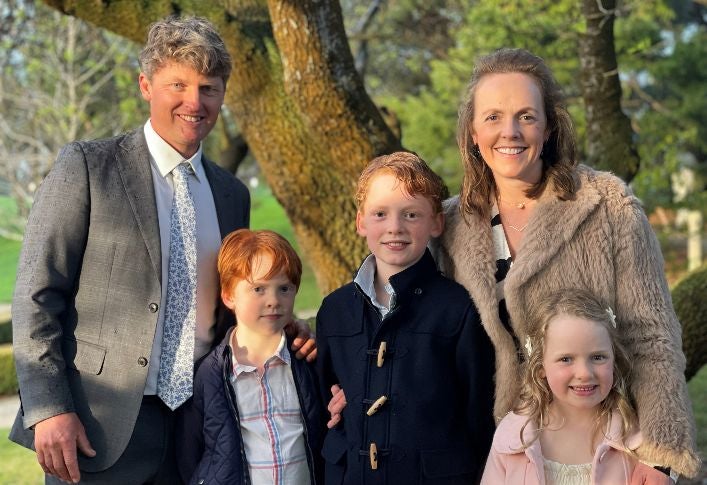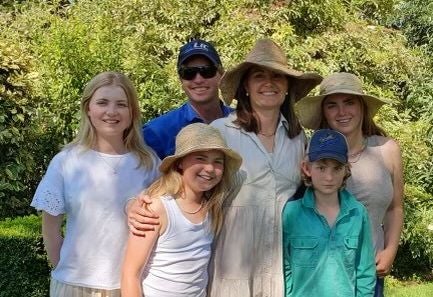Posted by on
09/02/2023
Robert and Louise Rigney with children James, Edward and Mariella.
Fortune has well and truly favoured the brave on the Rigney family’s Tasmanian farm, where a gutsy decision to convert a mixed enterprise into a dairy operation has underpinned exciting business growth.
From their original Cressy region soldier settler block “Delmont”, where they grew traditional sheep, beef, cereal and vegetables, Robert Rigney, together with brother George and parents Allen and Sally now milk a herd of 2,300 dairy cows across three properties – all despite having had almost zero dairy experience just 15 years ago.
A run of dry years in the mid-00’s, coupled with their investment in the Macquarie Settlement Pipeline – a privately funded irrigation scheme delivering additional water to the region – prompted the family to fully consider their return on asset.
“We did our numbers on the pipeline investment and how the land could best pay for it, and dairy emerged as the winner,” Robert explains.
“It became clear that growing grass was best suited – it’s not at risk of weather and seasonal harvest events, like potatoes, peas, broccoli, seed crops, poppies, plus our soils were running out of steam for high yielding crops, so growing grass was a sustainable, lower risk option.”
“It’s the most efficient, lowest cost feed we can put into cows and we can grow it year in, year out.”
The Rigneys’ were also conscious of the fact their mixed farm needed to support three families.
“We needed to make the farm viable for the future, which meant either buying more farming land or intensifying into dairy and growing a bigger operation, which made sense.”
Shifting direction into dairy
Robert laughs that he went to bed one night a mixed farmer, and woke up milking cows – yet his jovial demeanour belies the enormity of the Rigneys’ ambitions.
The family visited dairies across Tasmania and New Zealand conducting due diligence, before diving head-first into a seven month conversion consisting of farm mapping, grading laneways, changing fence lines, redesigning irrigation, digging a settling pond effluent system and building up a site for the new dairy.
An initial herd of 1,200 meant business, and upon their first season in 2008/09, Rob admits the learning curve was steep.
“Not being traditional dairy farmers perhaps gave us a certain amount of freedom to do things our way, we weren’t stuck on any one system, and we tried to identify the best aspects of other operations to use as a basic guide,” Robert said.
Yet he concedes a ‘fresh eyed’ approach sometimes proved costly.
“We certainly made mistakes along the way, but we’re continually learning and we’re really proud of the systems and people we now have in place.”
The challenges and opportunities of a new enterprise
Robert muses that dairy cattle are like elite athletes, “you need to give them the best if you want them to perform, because we’re asking a lot from them”.
As such, upon the conversion they wasted no time ensuring their animal husbandry and grazing management systems were efficient, and effective, followed by years of fine tuning.

Sally and Allen Rigney
The family – which also includes his wife Louise and their three children, plus George’s wife Penny and their four children – are not shy of hard work, and those early years learning the art of dairying are some of the family’s proudest.
“The cost of production while we were scaling up is something we were acutely aware of, we’ve learnt what a dollar is worth and have never been scared to get out of bed.”
He said “getting my head around milking cows” and sourcing labour were some of his greatest initial challenges.
“We’d come from a background where it was just my brother, father and I plus the occasional contractor, so moving to a dairy where you have to employ staff was a huge eye-opener.”
“Once we started expanding and needed more help we didn’t necessarily have the best team we could have, and we were constantly understaffed.”
Today, the Rigneys’ employ 25 staff and are proud of the culture and workplace systems they’ve developed over the past decade.
“It’s such a pleasure to be working with our team, everyone has their role, yet are multi-skilled so that there’s always a person who can step in if someone wants to go on holiday – there’s never a hole in the system and that’s eased the pressure enormously.”
The family also sources casual labour from the University of Tasmania’s ag faculty, helping encourage a new generation into the dairy industry, whilst building a network to tap into for future employment sustainability.
In a further nod to personal development and continual improvement, each month staff meet with Fonterra’s Area Manager Paddock Specialist Richard Rawnsley, who visits on-farm for, as Robert explains, “a different set of eyes”.
“We think it’s important that the staff are empowered to ask technical questions and develop their skills without always having to talk to ‘the boss’.”
Benchmarking has also proved a valuable tool, inspiring everyone on the farm to do better.
“We benchmark against each other, and it’s healthy competition that helps drive production and friendly banter within the boundaries of the business.”
A courageous move to grow the business
In addition to the family’s original property “Delmont”, converted 2013, and neighbouring “Newham Park” converted 2008/9 and purchased in two stages, 1995 and 2005, the Rigneys’ purchased a nearby dairy at Epping Forest in 2014 after the success of their initial conversions.
This farm was purchased initially as a ‘run-off’ block and milked 200 cows, and today supports a herd of 600 milking cows, young stock and grows barley and maize for on farm use.
“We take the view that pasture is the driver of our system, and use pasture management platform Pasture.io in conjunction with weekly pasture walks across all our farms.”
A more recent expansion, including the addition of a neighbouring property and a move into the Greens Beach region has afforded the family further scale, and negates the need to agist heifers.
“We purchased the new block “Taranaki”, which is next door to “Newham Park”, and “Bel Respiro”– which is a bit warmer and by the sea – as a run-off block for our dairy heifers, as we found agisting to be risky,” Robert explains. “You’re relying on other people to raise your future – these heifers are our next milking generation and we feel a lot more comfortable now having this all ‘in-house’.”
While pasture health remains a priority across each property, the Rigneys’ are also increasing their on-farm efficiency through renewables, with their three dairies now supported by solar power, and variable rate irrigation (VIR) technology helps ensure optimum water use efficiency.
A ‘dollar for dollar matched’ Woolworths grant 12 months ago has supported the adoption of milk metres in each dairy, which help track each cow’s production and fat protein, ultimately contributing to the operation’s breeding program.
“We keep it simple, healthy pastures, healthy animals and healthy staff morale are the keys to a productive, and happy farm.”
Having recently attended Rabobank’s dedicated Carbon Training Workshops, Robert believed the direction ag is heading is “exciting but will have its challenges”.

George and Penny Rigney, with children Abigail, Harriet, William and Arabella.
“It’s an evolving space for sure and the workshop was really valuable in helping get my head around the basics of carbon - I think we’re all going to need to get better educated at what we’re doing.”
In the coming weeks the Rigneys’ will start an asparagopsis seaweed trial in their dairy, testing the benefits of the seaweed feed supplement on each cows methane levels.
“It will be really interesting to see the results, it’s a learning curve and we’re all on the journey together – hopefully we can help uncover some really meaningful solutions right here on farm.”
The move into dairy has also ensured the business can support the whole family, and with a fourth generation now on the ground – seven so far – Robert said there would be a position for each of them on the farm in the future if they wanted it.
“There is so much opportunity in dairy and dairy support branches from the grain and beef blocks, making cheese, breeding and DNA, tourism – there are so many career pathways. It feels really rewarding to have helped continue to develop and build a business that we can now share with our children as the previous generations had done, hopefully we’ll get at least one back home!”
Rigney brothers to feature at Australian Dairy Conference
This month, Robert and George are guest panellists at The Australian Dairy Conference, and look forward to sharing their story of growth in the dairy sector.
“We’ve certainly had people looking over the fence, and we’re more than happy to share our learnings and attend the conference to find out more about the future of dairy.”
“When you look at the commodity price increases of beef, sheep and cereals, dairy prices really needs to be increasing a percentage more – we need that margin to retain our farmers, and attract new people to the industry.”
“No one knows the future of the price of milk, but it’s something we all need to have a handle on going forward and this is a topic I’m looking forward to exploring at the conference.”
“It’s also a great opportunity to network and catch up with others in the industry – and have a bit of fun in the meantime!”
